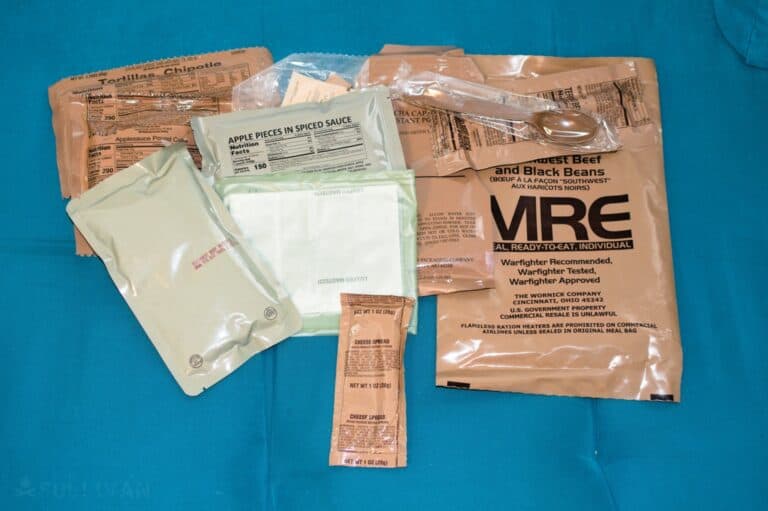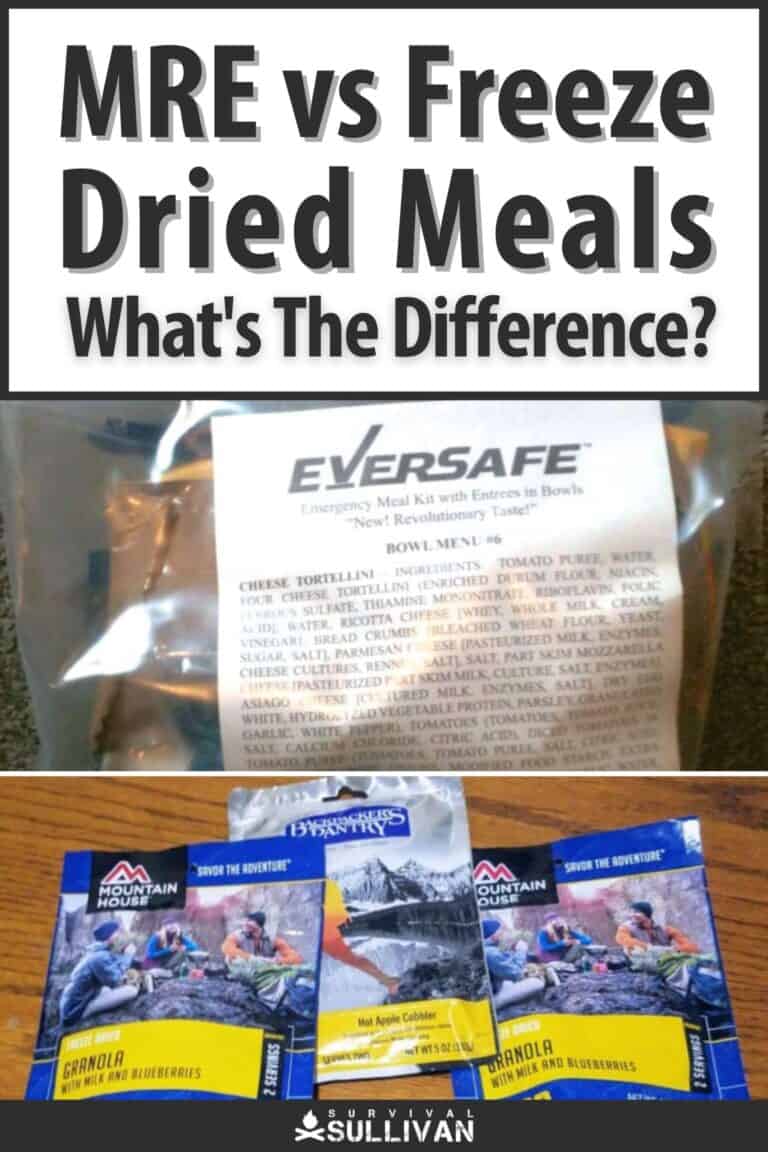Planning your next hiking trip? Getting an order list ready to stock up your food reserves in case of an emergency?

There are a variety of shelf-stable food choices on the market and you’ll often see terms like MRE’s or freeze-dried floating around as you research.
There is a large set of differences between the two and mistaking one for the other could make for an interesting situation.
If you’re a seasoned camper then you’ve at least experienced one of them. But what are the differences between the two?
A number of differences separate MREs and freeze-dried food. MREs are sealed packages of food that can be opened and eaten without any preparation. Freeze-dried meals need to be rehydrated before consumption.
If you’re interested in purchasing one or the other then read our short guide on the differences and the advantages of using either an MRE or freeze-dried foods.
Comparison Chart of an MRE and Freeze-Dried Meal
If you’re here to just learn what sets each kind of meal apart, here is a handy table that outlines it from a high level.
| Features | MRE | Freeze-Dried Meals |
|---|---|---|
| Shelf Life | 5-7 years | 20+ years |
| Storage Conditions | Cool temperatures between 55-70 degrees | Needs to stay dry and below 72 degrees |
| Preparation requirements | Can be eaten straight from the package either cold or hot | Needs to be re-hydrated in order to be able to be consumed |
Meals Ready-to-Eat(MREs)
- They are durable and meant to withstand some abuse
- A wide variety of food and beverages keeps things interesting
- An excellent source of calories and nutrition
- Can be eaten both hot and cold.
MRE were initially used by military forces and as relief aid for countries that needed it. Each country has their own style of MRE based on the local cuisine.
Eventually, military surplus stores started carrying rations for civilians to purchase and then companies started coming out with civilian-specific MREs.
Essentially it is a package filled with different food items and is meant to sustain a person for an entire day.
There are even MREs that can feed a person for 72 hours and beyond. Inside the package you’ll find entrees, side dishes, desserts, and other goodies that complement each other.
No preparation is required to consume an MRE as everything can be eaten hot or cold.
Most of them will come with a Flameless Ration Heater (FRH) which uses water to create a chemical reaction that generates heat.
The food then sits in the heater and passively gets hotter as the reaction runs its course.
How Long Do MREs Last?
MREs have a shelf life between 5-7 years under optimal conditions. Many people have eaten MREs decades after production with no adverse effects.
The reason for the shorter shelf life is that while the food is sealed, it is not dehydrated and can still spoil depending on the product.
Advantages of an MRE
MREs have several advantages that will benefit a person in a survival situation outside or if there is a food shortage in the city.
Freeze Dried Meals
- Incredibly lightweight
- Small form factor makes for easy packing
- Fully retains the taste, texture, and look of the food
- Calorie and nutrition specs are generally very high
Freeze-dried meals are single meals, usually in a mylar bag that have undergone a special process to have about 95% of the moisture removed from them.
This is done through a process called sublimation followed by vacuum sealing to get rid of the remaining moisture.
The remaining product retains the original taste, texture, and nutritional value. A lot of campers and long-distance hikers will use these to supplement their diet since it holds a lot of calories and daily requirements.
Freeze-dried meals need to be rehydrated fully before consumption, or they can be tough to chew and digest.
All you need is boiling water and a little patience as these meals can take up to a half hour to fully rehydrate. The results are worth it as the quality of the ingredients are generally very high.
They are incredibly light and small to pack away; However, they can be costly, ranging anywhere from $8 to $20 per meal.
Once you open the meal you have to finish it as it’s not resealable, and refrigerating the leftovers may be difficult in a survival situation.
Shelf Life of a Freeze-Dried Meal
The process eliminates almost all of the moisture, and the addition of oxygen absorbers fully preserves what’s in the bag…
This means that they have an incredibly long shelf life. In fact, freeze-dried foods can last up to 30 years under the proper conditions.
Keeping the freeze-dried meal in a cool and dark place will hinder the growth of mold and bacteria while the bag keeps any oxygen out of the food contents.
Advantages of a Freeze-Dried Meal
If you’re a lightweight packer or found a huge stash of these meals for a great price, freeze-dried food holds several advantages you might be interested in.
MREs vs. Freeze-Dried Meals
In the world of prepping and camping, each type of meal has its purpose and place.
Whichever one is better relies on your personal preference and if you’re able to cook the food when you need it.
MREs are great if you need an entire days’ worth of meals without having to cook anything.
The variety of snacks and beverages will keep you entertained and the durable packaging will keep it safe from animals.
The downside is that the food quality can be sub par depending on what company you decide to go with.
Keep in mind that the weight is substantially more than a freeze dried-meal as well, making your pack heavier as you travel.
Freeze-dried food is incredibly lightweight with the ability to cram it into any small space in your pack.
The nutrition content and flavor are kept intact and some of the entrees can be restaurant quality.
They tend to be expensive and you’re really limited to one meal at a time since they don’t have the variety that an MRE does.
Use these if you intend on traveling light and just want something hot to eat at the end of the day.
Final Thoughts
Both are valid options as survival meals with MRE’s more suited for civilians and situations within city limits. Freeze-dried food is easily transported and has a shelf life that spans decades.
You also know what you’re getting with the meal clearly on the package of freeze-dried meals. With an MRE you know the main entree but the snacks can be randomized.
Don’t pick them up based on price alone since there are high-price low quality meals, do research and watch reviews online.


Tom Marlowe practically grew up with a gun in his hand, and has held all kinds of jobs in the gun industry: range safety, sales, instruction and consulting, Tom has the experience to help civilian shooters figure out what will work best for them.
